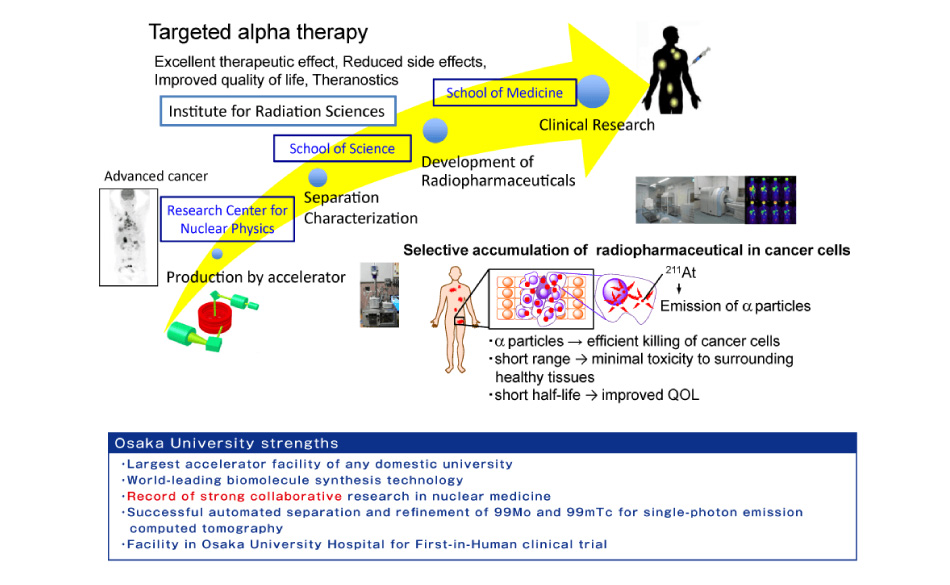
New framework of collaboration between medical science and physics fosters completely new avenues of research and leads to new areas of basic research for future nuclear medicine and therapy
Cooperation among the Core for Medicine and Science Collaborative Research and Education (MS-core), the Institute of Radiation Sciences, the Research Center for Nuclear Physics, the Graduate School of Medicine, and the Radioisotope Research Center has now led to a joint engagement in the development of a new targeted α-particle radiotherapy for treatment of intractable cancer, the development of the high-temperature superconducting Skeleton Cyclotron with high beam strength and reduced power consumption, and methods for producing alpha-emitting radionuclide in quantity and the automatic separation of generated nuclides. Further engagements will include the production of radiopharmaceutical candidates by bonding radionuclides with cancer-targeted agents and investigating the resulting therapeutic efficacy and side effects in order to determine the potential for clinical trials and treatments involving targeted α-particle radiotherapy.
FEATURE
Single stop from development to clinical application
Strong collaboration between nuclear medicine, accelerators, and nuclear chemistry
The only university with hospital facilities capable of First-in-Human clinical trial
World-leading biomolecule synthesis technology
RESULTS

Research progress
Regular supply for basic research in nuclear medicine
The technology has been established for production, separation, and refinement of astatine-211 (211-At) used in targeted α-particle radiotherapy, and regular supply has begun for nuclear medicine research. A method has been developed for the synthesis of several candidate pharmaceutical molecules and their 211-At labeling, and in vitro experiments revealed their extremely strong cytotoxic effects against cancer cells. Animal experiments have been carried out since 2017. Vital data have been steadily forthcoming on the pharmacokinetics and potent anti-cancer effect of the At ion and At-labelled pharmaceutical candidates in mice and rats.
Further development
Formation of International Therapeutic Core for Intractable Cancer Therapy by Medicine and Science Collaboration
In an effort centered at the Medicine-science-nuclear physics Collaboration Center Anteroom located in the MS-core, the budgetary request project “Formation of International Therapeutic Core for Intractable Cancer Therapy by Medicine and Science Collaboration” has achieved good progress. In fiscal year 2018, we entered Phase 2, which is aimed at creating an investigator-initiated clinical trial for targeted α-particle radiotherapy. Osaka University established the Institute for Radiation Sciences to promote unique radiation-related research and education such as new medical innovations in 2018. MS-core has collaborated with the Institute for Radiation Sciences to promote the interdisciplinary researches, such as targeted α-particle radiotherapy, between nuclear physics, nuclear chemistry, biomolecular chemistry, nuclear medicine, and radiology.